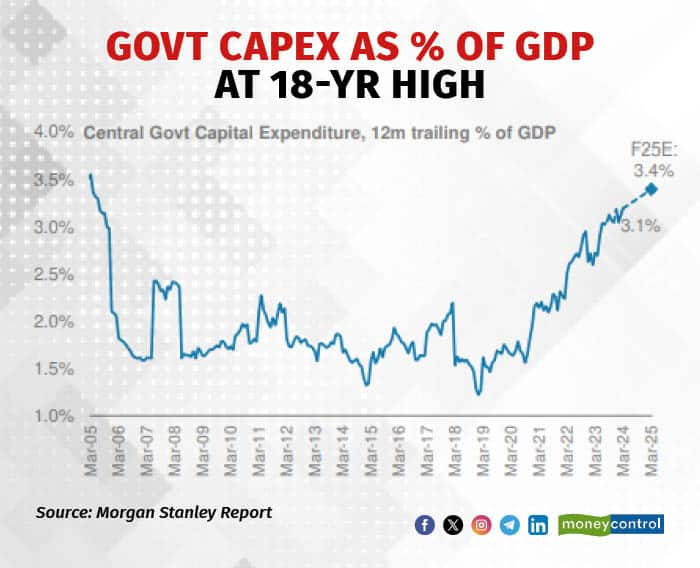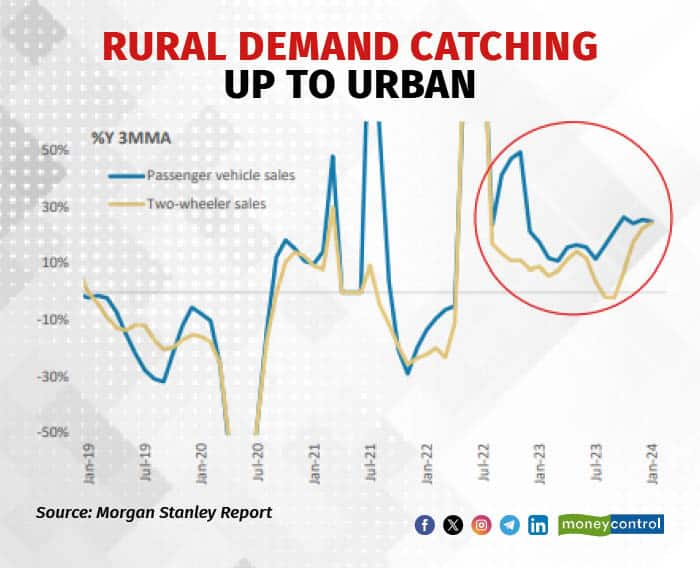



India’s capex cycle is on the rise after a decade-long fall, and is expected to continue rising, reminiscent of the boom period of 2003-2007, said Morgan Stanley.
India’s investment as a percentage of gross domestic product (GDP) can reach 36 percent by 2027 driven by public capex, rising exports, and a stable economy. Morgan Stanley said that a similar trend was observed during 2003-07 when India's investment ratio peaked at 39 percent.
The analysts noted a few key features of the current investment cycle, some of which show similarities between the two periods, while others show how this time it’s different and for better.
Public capex driving India's investment cycle
So far, analysts observed that the investment growth has been mainly driven by public capex, contrary to the 2003-07 cycle that was led by private capex.
Analysts believe that this public capex-led growth plays an important role in the sustainability of the overall capex cycle as infrastructure projects tend to face long gestation periods.
"We believe it is important for the public sector to undertake such spending to ensure a clear runaway for private capex to take off," they wrote in a recent note. The government fixed capex as a percentage of GDP rose to 4 percent in FY21 from 3.6 percent in FY19.

Also read: Fitch revises India's FY25 GDP growth forecast to 7% from 6.5%
Urban demand taking the lead; rural aiming to catch up
Similar to the earlier investment cycle, the current momentum is primarily driven by urban demand as employment and income levels recover, particularly in major cities. Analysts anticipate this momentum to gradually extend to rural areas, bolstering overall demand.
In the initial stages of the 2003-2007 cycle, rural demand trailed behind urban demand. However, with proactive policy measures such as the implementation of MNREGA, rural demand caught up and contributed significantly to the overall growth.
This cycle, the rural sector has seen double shocks of the COVID-19 pandemic and elevated inflation. As a result, two-wheeler sales growth has been much slower at an average of 4 percent in this cycle versus an average of 13.1 percent in the 2003-07 cycle.
That said, Morgan Stanley expects rural demand to catch up as rural FMCG sales picked up to 5.8 percent during Q4CY23 against 6.8 percent urban growth.

Also read: What does 12-year-low core inflation say about India's growth story?
Export boom reminiscient of 2003-07 investment cycle
India's investment cycle is further fueled by a surge in exports, echoing the trends seen during the 2003-2007 cycle. The country's goods and services exports market share has witnessed a notable increase, reflecting efforts to diversify supply chains internationally.
Analysts project continued benefits from international supply chain diversification efforts, anticipating India's combined goods and services export market share to rise to 4.5 percent by 2031.

Macro-risks to be limited this cycle v/s 2003-07
On the macro-front, analysts view risks as less concerning compared to the previous cycle, characterized by persistent inflation of around 10 percent during 2009-2014.

The current cycle exhibits strong positive productivity dynamics, supported by ongoing capital-deepening efforts. Analysts anticipate sustainable moderation of inflation to 4.5 percent, along with a shallow rate cut cycle of 50 basis points in their base case scenario to propel growth.
Disclaimer: The views and investment tips expressed by investment experts on Moneycontrol.com are their own and not those of the website or its management. Moneycontrol.com advises users to check with certified experts before taking any investment decisions.
Discover the latest Business News, Sensex, and Nifty updates. Obtain Personal Finance insights, tax queries, and expert opinions on Moneycontrol or download the Moneycontrol App to stay updated!
Find the best of Al News in one place, specially curated for you every weekend.
Stay on top of the latest tech trends and biggest startup news.